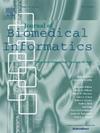Analysis of longitudinal social media for monitoring symptoms during a pandemic
IF 4
2区 医学
Q2 COMPUTER SCIENCE, INTERDISCIPLINARY APPLICATIONS
引用次数: 0
Abstract
Objective
Current studies leveraging social media data for disease monitoring face challenges like noisy colloquial language and insufficient tracking of user disease progression in longitudinal data settings. This study aims to develop a pipeline for collecting, cleaning, and analyzing large-scale longitudinal social media data for disease monitoring, with a focus on COVID-19 pandemic.
Materials and methods
This pipeline initiates by screening COVID-19 cases from tweets spanning February 1, 2020, to April 30, 2022. Longitudinal data is collected for each patient, two months before and three months after self-reporting. Symptoms are extracted using Name Entity Recognition (NER), followed by denoising with a combination of Graph Convolutional Network (GCN) and Bidirectional Encoder Representations from Transformers (BERT) model to retain only User-experienced Symptom Mentions (USM). Subsequently, symptoms are mapped to standardized medical concepts using the Unified Medical Language System (UMLS). Finally, this study conducts symptom pattern analysis and visualization to illustrate temporal changes in symptom prevalence and co-occurrence.
Results
This study identified 191,096 self-reported COVID-19-positive cases from COVID-19-related tweets and retrospectively collected 811,398,280 historical tweets, of which 2,120,964 contained symptoms information. After denoising, 39 % (832,287) of symptom-sharing tweets reflected user-experienced mentions. The trained USM model achieved an average F1 score of 0.927. Further analysis revealed a higher prevalence of upper respiratory tract symptoms during the Omicron period compared to the Delta and Wild-type periods. Additionally, there was a pronounced co-occurrence of lower respiratory tract and nervous system symptoms in the Wild-type strain and Delta variant.
Conclusion
This study established a robust framework for analyzing longitudinal social media data to monitor symptoms during a pandemic. By integrating denoising of user-experienced symptom mentions, our findings reveal the duration of different symptoms over time and by variant within a cohort of nearly 200,000 patients, providing critical insights into symptom trends that are often difficult to capture through traditional data source.

大流行期间监测症状的纵向社交媒体分析。
目的:目前利用社交媒体数据进行疾病监测的研究面临着诸如嘈杂的口语和在纵向数据设置中对用户疾病进展的跟踪不足等挑战。本研究旨在开发一种用于疾病监测的大规模纵向社交媒体数据收集、清理和分析的管道,重点是COVID-19大流行。材料和方法:该管道通过筛选2020年2月1日至2022年4月30日期间的推文中的COVID-19病例启动。每位患者在自我报告前两个月和报告后三个月进行纵向数据收集。使用名称实体识别(NER)提取症状,然后结合图卷积网络(GCN)和变压器(BERT)模型的双向编码器表示进行降噪,以仅保留用户症状提及(USM)。随后,使用统一医学语言系统(UMLS)将症状映射到标准化的医学概念。最后,本研究通过症状模式分析和可视化来说明症状患病率和共现率的时间变化。结果:本研究从与covid -19相关的推文中发现191,096例自我报告的covid -19阳性病例,回顾性收集了811,398,280条历史推文,其中包含2120,964条症状信息。去噪后,39 %(832,287)的症状分享推文反映了与用户相关的提及。训练后的USM模型F1平均得分为0.927。进一步分析显示,与三角洲型和野生型相比,欧米克隆型期间上呼吸道症状的患病率更高。此外,野生型毒株和δ型毒株明显同时出现下呼吸道和神经系统症状。结论:本研究建立了一个强大的框架,用于分析纵向社交媒体数据,以监测大流行期间的症状。通过整合用户体验症状提及的去噪,我们的研究结果揭示了不同症状随时间的持续时间,并在近20万患者的队列中通过变化,提供了通过传统数据源通常难以捕获的症状趋势的关键见解。
本文章由计算机程序翻译,如有差异,请以英文原文为准。
求助全文
约1分钟内获得全文
求助全文
来源期刊

Journal of Biomedical Informatics
医学-计算机:跨学科应用
CiteScore
8.90
自引率
6.70%
发文量
243
审稿时长
32 days
期刊介绍:
The Journal of Biomedical Informatics reflects a commitment to high-quality original research papers, reviews, and commentaries in the area of biomedical informatics methodology. Although we publish articles motivated by applications in the biomedical sciences (for example, clinical medicine, health care, population health, and translational bioinformatics), the journal emphasizes reports of new methodologies and techniques that have general applicability and that form the basis for the evolving science of biomedical informatics. Articles on medical devices; evaluations of implemented systems (including clinical trials of information technologies); or papers that provide insight into a biological process, a specific disease, or treatment options would generally be more suitable for publication in other venues. Papers on applications of signal processing and image analysis are often more suitable for biomedical engineering journals or other informatics journals, although we do publish papers that emphasize the information management and knowledge representation/modeling issues that arise in the storage and use of biological signals and images. System descriptions are welcome if they illustrate and substantiate the underlying methodology that is the principal focus of the report and an effort is made to address the generalizability and/or range of application of that methodology. Note also that, given the international nature of JBI, papers that deal with specific languages other than English, or with country-specific health systems or approaches, are acceptable for JBI only if they offer generalizable lessons that are relevant to the broad JBI readership, regardless of their country, language, culture, or health system.
 求助内容:
求助内容: 应助结果提醒方式:
应助结果提醒方式:


